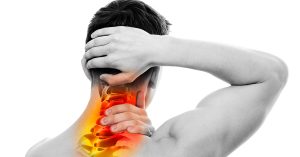 Your spine is an amazing part of the body and is responsible for so many of the functions important for day to day life. The most mobile part of the spine is the neck, or cervical spine. The mobility of the cervical spine gives us the range of motion needed to move our heads around. However, this increased mobility comes at the cost of stability, making the neck more vulnerable to injury.
Your spine is an amazing part of the body and is responsible for so many of the functions important for day to day life. The most mobile part of the spine is the neck, or cervical spine. The mobility of the cervical spine gives us the range of motion needed to move our heads around. However, this increased mobility comes at the cost of stability, making the neck more vulnerable to injury.
Sudden or jarring movements can stretch the tissues surrounding the cervical spine and cause a sprain or strain. Things that can cause neck sprains and strains include car accidents, falls, or activities where there is an extreme extension (bending back) or flexion (bending forward) of the neck.
If you are experiencing pain in your neck after an accident, fall, or awkward movement, you should consider seeking medical attention. While a neck sprain will often heal on its own with rest and proper care, a doctor can help ensure you aren’t allowing a more severe injury or condition to go unchecked.
Is it a Sprain or a Strain?
Although the terms are often used interchangeably, neck sprains and strains differ in a few ways. Both involve injury to the soft tissues of the neck, but the types of soft tissues affected are what set them apart.
- Strains affect the muscles and tendons of the neck. One of the most common examples would be whiplash caused by an automobile accident.
- Sprains primarily affect the ligaments in the neck, but may also affect other elements of the soft tissue like cartilage, blood vessels, or bursae (fluid-filled membranes that cushion the joints).
Because both injuries affect the same area, you will notice many of the symptoms of neck sprains and strains overlap. However, there are some differences in symptoms that can make it easier to tell them apart.
Symptoms of Neck Sprains
A neck sprain will obviously present with symptoms in the neck, but it can also affect other parts of the body, especially if they are in the same area or close to the spine. You may feel symptoms in the back, shoulders, and head as well as in the actual neck. Some symptoms of neck sprains include:
- Neck pain and stiffness
- Decreased range of motion
- Headache in the back of the head
- Upper back pain
- Shoulder pain
- Dizziness*
- Numbness in hands or arms
- Tingling or weakness in arms
- Ringing ears
- Increased fatigue and/or irritability
- Difficulty sleeping
- Difficulty concentrating
*If you are experiencing a severe headache, dizziness, pain radiating to your arms and legs, numbness, or weakness then you should seek immediate medical attention. These may be signs of a more serious neurological condition.
Symptoms of Neck Strains
If you have a neck strain, you might experience some of the same symptoms of a sprain. Often symptoms will not occur until a day or two after the trauma.
- Neck pain and stiffness
- Decreased range of motion
- Back pain
- Muscle spasm
- Difficulty performing everyday tasks
Diagnosis
If you are experiencing the above symptoms, it’s best to err on the side of caution and schedule an appointment with your doctor. As noted above, certain serious and severe symptoms warrant immediate medical attention. Also, if your symptoms persist or get worse, you should get attention to rule out more serious injury. Your doctor can diagnose neck sprains and strains through two basic methods: a physical exam and diagnostic imaging.
- Physical Exam: Your doctor will ask for information about what led to the injury, your symptoms, pain level, and any other injuries or conditions in your medical history that may be related or relevant. The doctor should also palpate (press against) your neck to check for pain points, inflammation, and muscle spasms. A range of motion exam to determine how far and which ways the neck can be moved. A neurologic exam will also be performed to test reflexes and motor skills and identify and areas of numbness or tingling.
- Imaging Studies: If a physical exam is not enough to make a definitive diagnosis, the doctor may also recommend having diagnostic imaging. Usually, x-rays are used to examine the neck and spine and rule out things like dislocation, arthritis, or fracture. In some cases, a CT scan or MRI may be necessary to visualize the muscle.
Treatment
Most neck sprains and strains can be treated with a combination of pain relievers and physical or “hands-on” therapies to alleviate pain and discomfort while the tissue heals and repairs itself. Your doctor may prescribe medications like muscle relaxers or recommend over the counter drugs like ibuprofen or acetaminophen. Other treatments that may be recommended include:
- Cervical collar for head support
- Physical therapy
- Ice packs
- Moist heat (gradually after icing for a few days)
- Massage
- Ultrasound therapy
Schedule an Appointment
If you are experiencing any spinal or neck issues, including neck sprains and strains, Dr. Nael Shanti of Cary Orthopedics Spine Center is available to help with diagnosis and treatment. Call 919-297-0000 to schedule an appointment.
